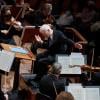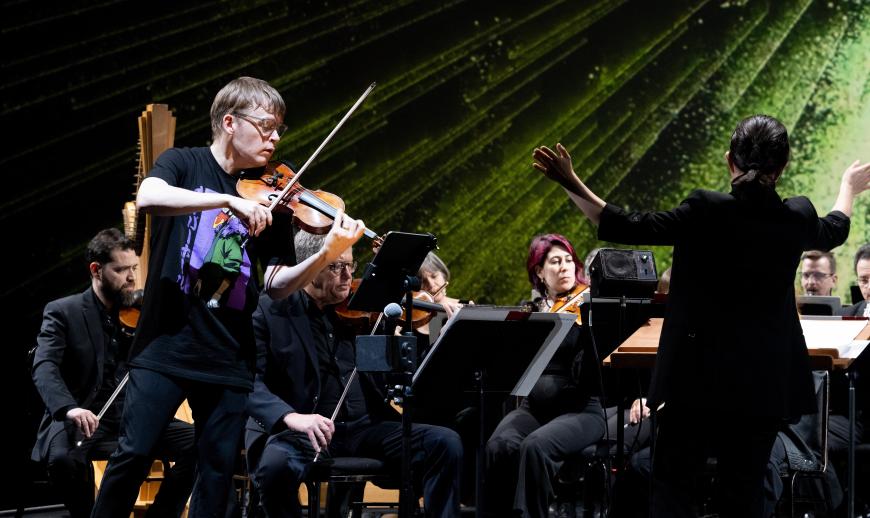
During the 2022–2023 season, the schedule for SoundBox, the alternative concert series in an alternative space in Davies Symphony Hall, includes slots for three of the San Francisco Symphony’s collaborative partners. On Friday, Feb. 10, one of those partners, violinist Pekka Kuusisto, curated a program with Swedish composer Jesper Nordin.
The advertising for SoundBox calls out its unpredictability, and that’s fair. Going in, the audience doesn’t know anything about the repertory or performers beyond the announced curators. After several years of SoundBox programs, though, the format is well known: approximately 90 minutes of short works (often individual movements taken from longer pieces), all focused on a theme, starting at 9 p.m. and running to nearly 11 p.m. after two intermissions, and with videos or photos projected on multiple large screens.
The audience can nibble on snacks and drink beverages alcoholic or not, seated on low cushions or on barstool-height chairs at high tables. Photography is permitted! This undoubtedly sounds overly casual for some concertgoers, but in my experience the SoundBox audiences are exemplary in all ways, rapt and respectful, appreciative of the music and the performers. And for a reviewer, it’s pure luxury to have a table, rather than a knee, for taking notes.
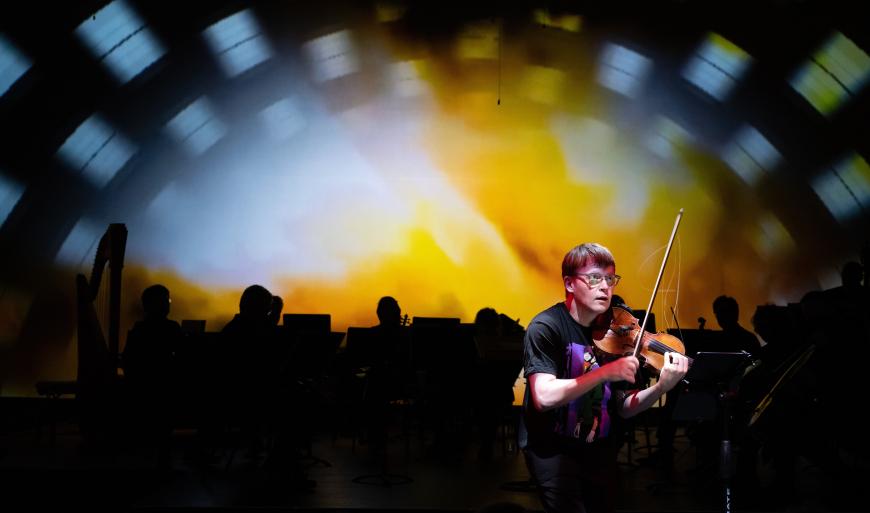
A pair of works by Nordin bookended the concert, both featuring Kuusisto as the soloist. Calm like a bomb, for violin and electronics, requires such intense playing that by its conclusion several hairs had detached from one end of Kuusisto’s bow. The violin swoops, plays whole passages on one note, and plays wild folklike music, sometimes over a horror-film thrumming bass line. Sometimes it felt as though the music was screaming at you; I could have done with about two minutes less of it.
The program closed with Convergence – Phase One, a concerto for violin and chamber orchestra. Convergence includes electronic instruments invented by Nordin, one a motion sensor under Kuusisto’s control and producing string-orchestra sounds. Nordin played the other with hand gestures reminiscent of a theremin. The sounds it produced were more like extreme electric guitar playing, not a surprise for a composer whose work freely incorporates rock music into classical forms.
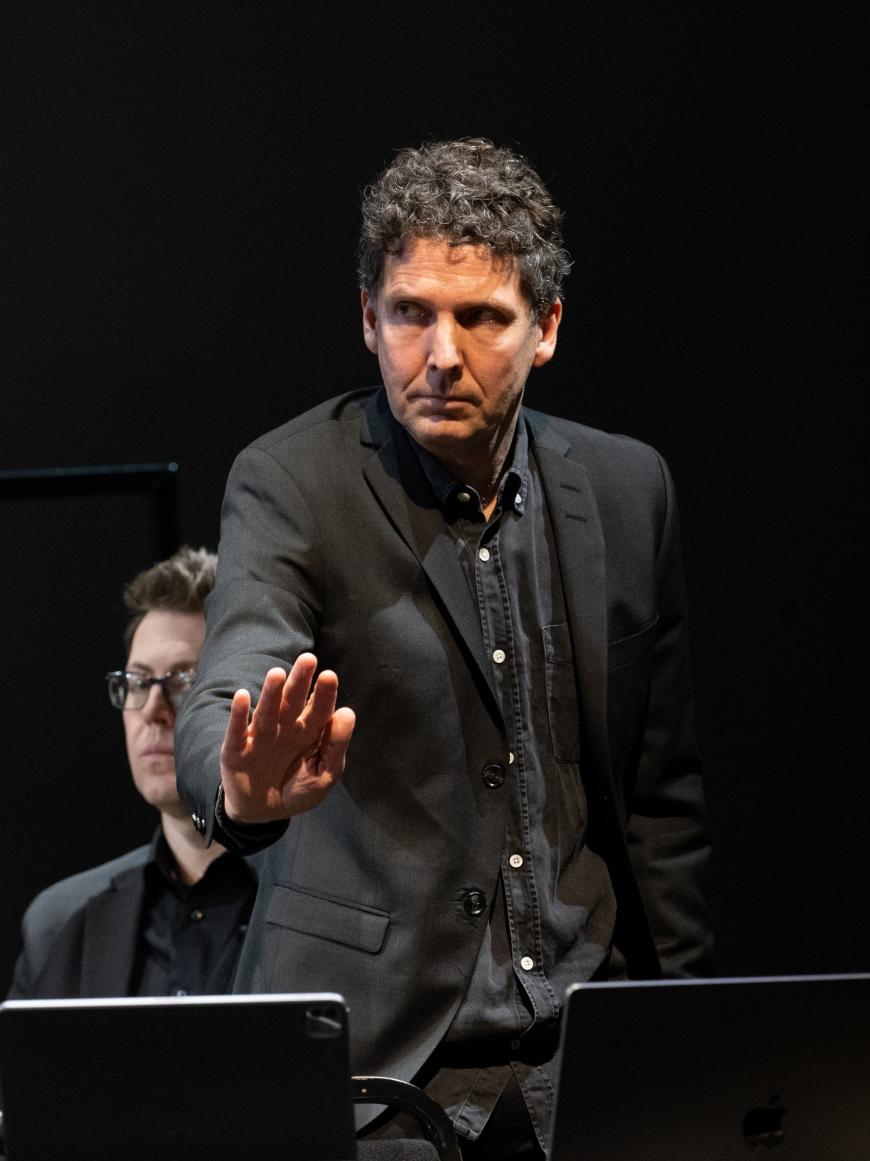
In his spoken introduction, Nordin discussed the role of quarter tones in Swedish folk music, where they’re called light blue or dark blue. Convergence has plenty of blue notes, sections of ruminative beauty, and wild outbursts, ranging in style from folky to hard rock. Like calm like a bomb, it might benefit from some trimming. In addition, some instruments in the work just weren’t audible in the general welter of sound, despite the Meyer Sound Constellation system used in the SoundBox space. Nordin mentioned that a longer version for larger orchestra will be performed at the SF Symphony, giving a glimpse of a future season with a second opportunity to hear the work.
The two Nordin pieces left no doubt at all of Kuusisto’s virtuosic prowess and intense focus. Interspersed among the evening’s other works, he played, with relaxed beauty and refined tone, a pair of traditional tunes, “Arepolska,” after Per Danielsson, and “Polska,” after Pekkos Per. You could have danced to each of these.
The program only went awry once, in a strangely tentative performance of Henry Purcell’s brief Fantasia 1 in D Minor for violin, viola, and cello, which sounded as though the players hadn’t heard much 17th-century consort music. A different Purcell fantasy, sonorously arranged for a small brass ensemble by Elliott Carter, fared considerably better.
One standout work on the concert was Movement I from Giacinto Scelsi’s Kya, for the odd ensemble of clarinet, bass clarinet, English horn, viola, cello, French horn, trumpet, and trombone. Starting with an offbeat fanfare, the movement shifted in timbre from instrument to instrument, with trills, slides, and, improbably, quacking noises. The clarinet part was very much to the fore, giving principal player Carey Bell a grand opportunity to show off his virtuosity. Fausto Romitelli’s “Seconda domenica” (Second Sunday) from Domeniche alla periferia dell’impero (Sundays on the periphery of the empire) likewise featured an oddball ensemble of flute, bass clarinet, violin, and cello, in which woodwinds double on kazoo. This puckish and punkish work slid and squawked and somehow also had contrapuntal aspects.
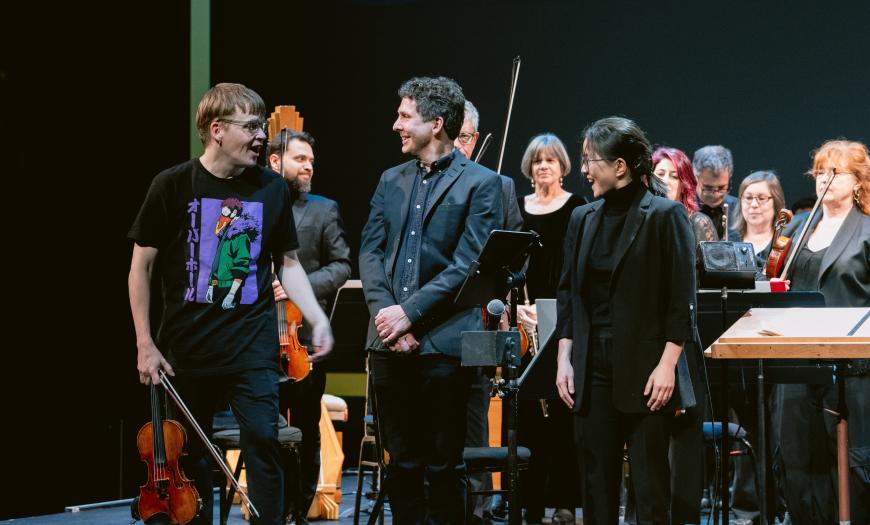
Also on the program were an Impromptu for strings by Jean Sibelius, pensive to start, then lilting in its faster section, and a single tantalizing movement, “Melankolia,” from Einojuhani Rautavaara’s three-movement suite Cantus Arcticus, also known as the Concerto for Birds and Orchestra. The video accompaniment for “Melankolia” appropriately included birds winging their way across empty skies. Molly Turner, a member of the SFS music staff and a Salonen Fellow at the Colburn School in Los Angeles, excellently conducted much of the music on the program.



